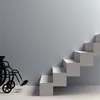[Independence Day] Want to contribute to India’s annual GDP? Now is the time to invest in Assistive Technology
As we celebrate our 75th Independence Day, it's time to see how we can include over 26.8 million people living with disabilities into the economic mainstream
Technology has made our lives easier than ever before. From grocery shopping to banking needs, all the financial tasks and management can now be done through digital means. Though technology has paved the way for our brighter future, we are yet to take advantage of it for the betterment of India’s disabled population. According to research done in 2011, 26.8 million Indians live with disabilities, which is one of the highest in the world. Besides facing disability, these people live in a bubble of criticism, which makes their lives even more difficult.

(Representational image)
In India, a majority of employers see the disabled of society as a liability and refrain from considering them for jobs, pushing them towards the poverty line. This is backed by a report that states only 34 lakh disabled people (out of 1.34 crore) are employed in the country. This means we are forcing millions of young people with disabilities to be dependent on social security.
As most humans enjoy the convenience of living in a digital world, why should the disabled population be left behind? With the growing awareness of assistive technology (AT) and innovations, several established tech companies and young start-ups are stepping up their efforts to address the needs of individuals with disabilities in India.
Assistive Technology- A friend that a disabled person never had
Assistive technology can hold a bright future for the disabled and allow them to carry out their daily activities without being a burden on others. About 76 percent of children who received assistive devices were able to remain in a regular classroom. 67 percent of people with disabilities reported that assistive technology had helped them to obtain employment. Here’s more about how technology is creating a positive impact:
Health factor
It’s tough for disabled people to move around without constant assistance. There are chances of accidents and threats to personal safety. Providing the right prosthetics and orthotics to the disabled population will allow them to work, play, and live healthier lives. For example, Symbionic is a start-up focused on building a custom-made bionic arm for amputee at a very affordable cost with the help of artificial intelligence to help them overcome their sense of loss, be more confident about themselves and feel empowered.
Social factor
Being disabled may restrict a person from having a social life. In a country like India, there is a lack of proper transportation facilities for the disabled and even most of the buildings are not accessible to persons with disabilities. By having the right assistive tools by their side, people with mobility challenges can travel without any worries. Kickstart and True Consulting are two Indian start-ups that are making transportation accessible to people with partial/reduced/limited mobility.
Economic factor
A majority of India’s disabled population is unemployed and are unable to contribute to the country’s overall economy, leading to the loss of 5-7 percent of the annual GDP. Assistive technology enables academic engagement and enhances employment opportunities among people with disabilities.
About 62 percent of working-age people with disabilities were able to reduce dependency on their family members, and about 92 percent of employed persons reported that technology helped them to work faster or better.
Over 12 million visually impaired people in India (57 million globally) don’t have real-time access to content. Bangalore based, Trestle Labs, is empowering the Blind and Visually Impaired community towards inclusive education and employment through their “Kibo” product suit to access any content through audio in 12 Indian languages. Imagine giving the right assistive tools to 26.8 million disabled people in India. If and when they start working, they can make a significant contribution to the country’s economy.
How can India become a pioneer in Assistive Technology?
As per the latest estimates, one billion people need assistive products today and more than two billion people around the world would need at least one assistive product by 2030. Right now, barely 10 percent of the population has access to them. This is because the governments and the donor organisations treat this as a charity case instead of a profitable investment. According to a dedicated report, Global Disabled & Elderly Assistive Technologies Market was valued at $22,466 million in 2016 and is anticipated to reach $37,610 million by 2023, registering a CAGR of 7.8 percent from 2017 to 2023.
Given the huge opportunity in the assistive technology market, there is potential for India to become the world’s best assistive technology hub. This can be done by creating an ecosystem of assistive technology innovators and entrepreneurs that can come together to build suitable strategies and products for the disabled population. Further, investors, thought leaders, practitioners, researchers, corporations, government, NGOs and Institutions should be a part of this ecosystem as well.
It’s time for us to come together as a community and prioritise action & investment in the assistive sector. If we can make this happen, India will see serving not only its own disabled population but millions of people in the world as well.
Edited by Diya Koshy George

![[Independence Day] Want to contribute to India’s annual GDP? Now is the time to invest in Assistive Technology](https://images.yourstory.com/cs/5/80396100-2d6d-11e9-aa97-9329348d4c3e/Flipkart_(5)1566392871934.png?mode=crop&crop=faces&ar=2%3A1&format=auto&w=1920&q=75)





